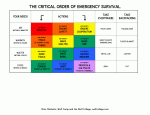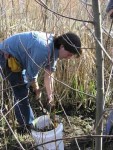Here at Wolf Camp, we get a lot of questions about Stinging Nettle. It is awesome that so many people are interested in it! It is truly an amazing plant. So, we decided to compile a list of the most frequently asked questions, so that others can learn to use and appreciate Nettle as well.
Stinging Nettle FAQ:
What is the plant in Washington that causes stinging?
It is Stinging Nettle, Urtica dioica.
Is there a time of year when Nettles don’t sting?
No, they sting year round. Even the baby nettles can give you a nice welt on your ankles.
How do I harvest Stinging Nettle?
Head on over to Wolf Camp’s comprehensive guide to Harvesting & Processing Sting Nettle (+ some recipes!)
If I cook Nettle, can it still sting me?
Nope! Also if you dry it, it won’t sting you. You can even it raw without being stung. We teach a special way to harvest it barehanded and how to eat it raw.
When do I gather/harvest Stinging Nettle?
Here in the Pacific Northwest, they start growing as early as January, up through the snow.
Harvest them in the early spring, before they flower. Don’t harvest for eating once they’ve flowered, as they could contain a compound that is hard on the kidneys and/or bladder (educational sources give differing opinions on which organ).
Depending on your region, new nettles come up in the fall and can be harvested before they’re killed by frost.
When do I gather/harvest Stinging Nettle for its fiber?
This is a great question! We like to harvest after they’ve already gone to seed (so that we don’t interfere with that part of their reproduction cycle) but before the rainy season causes the stalks to rot.
How do I dry my Stinging Nettle? How do I store my dried Stinging Nettle?
Check out Wolf College’s comprehensive guide to harvesting and processing Nettle
How do I know if Stinging Nettle is ready to be picked?
As long as it’s not flowering or covered in some strange contaminant, it’s ready. Try to leave the baby nettles alone, so that they can grow. Harvest only what you need, and remember to harvest in different areas, so that the Nettles have the greatest chance of healthy growth.
Can I put raw Stinging Nettles in my salad?
I wouldn’t! You are very likely to get stung in the mouth. Raw nettles will still have formic acid in them, and the hairs will still be able to sting you. A more preferable way to eat them is to saute them like spinach until crispy, and then sprinkle the crispy nettle as a topping on your salad.
How do I dehydrate Stinging Nettle?
You can dehydrate them using a dehydrator, or dry them in the oven. For the oven method, place your clean Nettle neatly on a cookie sheet and warm them slowly in the oven at 170- 180 °F for 1-2 hours. The temperature must be below 200, otherwise the plant will bake rather than dry. The oven door must be left open! The air needs to be able to circulate to dry out the Nettle, so that it doesn’t bake. So, be very careful using this method.
For other drying methods, check out Wolf Camp’s comprehensive guide to processing Nettles.
What are some Stinging Nettle Recipes?
Check out these Wolf Camp Recipes: Nettle Shampoo / Stinging Nettle Tea / other Nettle Recipes
How do I make Nettle Stew?
Make a stew and throw in some clean and fresh Nettle leaves. They cook just like any other dark leafy green (spinach, chard, etc)!
How do I use dried Nettle leaves?
It depends on what you want to make. You can use them to make Nettle tea and Nettle shampoo. You can add them to recipes or herbal remedies. You can feed them to your dog too — a little sprinkle on their food with a bit of water mixed in, or nettle tea (appropriately cooled) on their food. Our camp dog, Lily (45 pound border collie x blue tick coon hound), gets about a teaspoon of crushed dry leaves along with about a 1/4 cup of water added to her dry food each morning.
Can you freeze Nettles for eating?
Yep! You can also make Nettle Pesto and freeze them into ice cube trays, so that when you want to make pasta with pesto, you have it all ready to go.
There’s a bird’s nest next to Stinging Nettle, what do I do?
Leave it alone! It’s important that we do not disturb nests (and it’s illegal).
What part of the Nettle stings?
Stinging Nettle has tiny hairs all over (top and bottom of the leaf, and even on the stems and stalk) that are hollow and very sharp. Think of them like little hypodermic needles — when we brush up against Nettles the wrong way, they inject formic acid (and some other constituents) into our skin. That’s what gives us the stinging sensation.
Do the young Nettles sting?
Yes! Unfortunately sometimes the tiny baby Nettles can give us good-sized welts.
Can I make a basket out of Nettle?
Yes, the fiber can be used to make cordage, which can then be used to weave a basket. Or make a rope, or a fishing line, or a bow line, or a trap line, etc…
How do I use Stinging Nettle?
You can do almost anything with this amazing plant! You can eat it raw or cooked, you can make a tea, you can make natural beauty products like Stinging Nettle Shampoo, you can use the fiber found in the stalk to make cordage, you can whip painful joints (urtication) and other joint/bone problem areas like sciatica to promote bloodflow to the area.
How do I cook nettle for medicine?
Stinging nettle is extremely nutritive for the body and is even one of the top survival foods for the Pacific Northwest! Typically, stinging nettle is enjoyed as a nutritive infusion, where about 1oz (in weight) of plant material is steeped in 1 quart of hot water for 4 – 12 hours. You can also supplement your diet with yummy cooked/ sauteed nettle.
There are many sources that suggest that nettles could be used for treating many different ailments. Our best recommendation is to consult your naturopathic physician or qualified healthcare practitioner.
Is Stinging Nettle Tea delicious?
Yes!! Check out our recipe
Why are some Stinging Nettle stings stronger than others?
I do not know the answer to that. From my own experience, it really just depends on the plant. I’ve brushed up against some Nettle that never stung me, and have received some stings from a nettle that I swear I never touched.
From experience, it seems that the longer you take to treat a nettle sting, the longer the sensation lasts.
Does Stinging Nettle stop stinging when it’s pulled off the stalk?
Nope! Because the parts that stings you are found on all aerial parts of the plant.
Can I make tea from fresh stinging nettle?
Yes, but in my opinion it has a stronger taste than the tea made from the dried material.
Do Stinging Nettles smell?
Not really, no more than any other leafy green. They don’t have a ‘stinky’ or ‘sweet’ smell.
For all the answers to your questions, check out:
Learn how to confidently identify plants using their unique family patterns in this in-depth video by author of Botany in a Day, Thomas Elpel!
If you have any questions, please leave us a comment!
 Hannah began her apprenticeship at Wolf Camp in 2013 and graduated as a lead herbal instructor in 2014. Join Hannah and other Wolf College wild chefs during our annual Wild Cooking & Ethnobotany Expedition: The Herbal Foray the second week of July on Lake Sammamish near Seattle.
Hannah began her apprenticeship at Wolf Camp in 2013 and graduated as a lead herbal instructor in 2014. Join Hannah and other Wolf College wild chefs during our annual Wild Cooking & Ethnobotany Expedition: The Herbal Foray the second week of July on Lake Sammamish near Seattle.
Hannah graduated from the University of Oregon in 2014 with a Bachelor’s Degree in Foreign Languages. She has her own blog, where she writes about her love for crafts, animals, plants, cooking, and the outdoors: rainmountaincrafts.com















I got some screens and dried a whole bunch of nettle leaves, but I did not get back to them for a couple months. How long do they remain potent? And does the potency decrease with time, or also other factors, like sun and Heat? How do you know if the dried leaves are still potent?
Great questions, and yes, like everything they deteriorate, but without scientific control, there are no objective answers other than taste which is the time-tested way herbalists/chefs “know” subjectively. Experience is the only way, but be advised on all the precautions in the article and comments. Thanks, – Chris
Can you use stinging nettle for tea even after it seeded
Not really. One cuppa would be fine, but the cystoliths (calcium crystals) that develop in the plant as it is flowering in the spring need to be avoided except in short-term emergency survival situations. For tea, harvest and dry in the spring before the plants flower. Until then, order dried nettle from Mountain Rose Herbs or another trusted distributor.
Do stinging nettle sting when they come out and are they tiny and black? I am having a severe allergic allergic reaction to something and I think it might be stinging nettles , if not what else could it be?
Hi Erma. Without a photo etc we can’t really help ID what you found, but stinging nettle does sting when small. If what you found is all black then may not be stinging nettle, although some have black tinges when assumed to have a lot of iron content, perhaps from high amounts in the soil its growing in. The term “severe allergic reaction” is troubling as it indicates a danger of anaphlaxis so hoping you sought medical help, or hopefully you just meant you had a localized rash? Please look to your medical provider and regional university with specialized research departments for guidance, thanks.
Hi
I recently dried nettles to feed degu. I was surprised to find that even though the acid had disappeared, the stingers themselves appeared to be intact. They could be pulled out of the skin. What would you suggest?
I’m not sure what “feed degu” is but if it’s irritating to your skin you could wear clean leather gloves and crumble the dried leaves up to further break down the nettle hairs before using?
When are nettles flowering? For instance, I can see on some plants tiny starts to the flowers just beginning to emerge. Are these a no, or can we eat them as the flowers aren’t blooming?
Hi Laura. Here in Western Washington they flower from about late April through June and then go to seed. Yes once you see those flower buds starting just skip those and only harvest from plants that aren’t flowering yet. Eating an overlooked plant that was flowering probably won’t hurt a person but eating a whole meal of nettle that was flowering might.
Hello,
Am north of Seattle. Will nettle grow year round in a greenhouse sheltered from freezing temps and given supplemental light during winter?
Many thanks,
Bob
Hi Robert. At sea level in Western Washington nettles are pretty live year-round and I have even harvested new shoots/leaves in January during warm spells. They do well in large pots as long as rhizomes are allowed to stretch out or cut before binding up in the pot, but we haven’t experimented with putting them in greenhouses, so let us know how that goes for you.
I would like to freeze dry nettles for later use. Do I need to blanch them or can I freeze dry them as is without them stinging later. You didn’t blanch to dehydrate and it removed the sting, would it be the same for freeze drying? Thanks!
Great question. We have not freeze-dried nettles yet either. Our guess is it would be good to blanch them, but let us know how it works, thanks!
I have dehydrated organic stinging nettles … can I just sprinkle the dried chopped leaves around my flowers for fertilizer? We’ve gotten so much rain, I thought it may be longer lasting if I just sprinkle the leaves around the flower stalk base. So it just breaks down slowly to add nourishment 🤷♀️. Do you know if it would detour aphids like earwigs by chance? I’m trying everything to help detour earwigs from my zinnias and dahlias. Tried Neem, Vaseline, olive oil, sluggo, diatomaceous earth, bughut, and trying nettles now. Thought I’d ask you guys if you know??? Thanks for any info🫶🏻
Great questions! We haven’t tried that yet. Let us know if you find something that works for you!